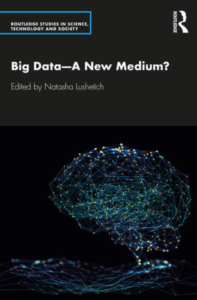Research outputs 2020
Big Data – A New Medium? London and New York: Routledge, 2020
Edited, with an introduction by Natasha Lushetich.

Big data architectures are increasingly determining classificatory systems in the social, educational, and healthcare realms transforming political questions into technical management. Data, and their multiple arborisations, have become new epistemic landscapes. They have also become new existential terrains.
Drawing on a range of methods from across science and technology studies, digital humanities and digital arts, this book presents a comprehensive view of the big data phenomenon through astute analyses of cognitive automation machinic hallucinations, biometric governance, algorithmic labour, the fate of datafied memory institutions, digital frottage and data doubles.
For more information:
https://www.routledge.com/Big-DataA-New-Medium/Lushetich/p/book/9780367333843
BeHere: Prosthetic Memory in the Age of Digital Frottage
Natasha Lushetich & Masaki Fujihata in Lushetich, Natasha (ed.) Big Data – A New Medium? London and New York: Routledge, 2020.
Masaki Fujihata’s work BeHere: The Past in the Present (2018 –) is simultaneously an augmented reality installation and a mobile phone application. In this chapter, Lushetich and Fujihata focus on the latent image emerging from digital frottage, remediated co-presence, and the affective anarchive, in order to articulate the ways in which vast quantities of found, data-processed images of a bygone Hong Kong era, micro-events, and micro-temporal human scales, co-create prosthetic memory.
For more information:
https://www.taylorfrancis.com/chapters/edit/10.4324/9780429319556-13/behere-natasha-lushetich-masaki-fujihata
Indeterminate Futures / The Future of Indeterminacy
International Cross-Disciplinary Conference, 13 – 15 November 2020.
For more information:
https://indeterminacy.ac.uk/indeterminate-futures/
‘Things begin to speak by themselves’: Pierre Schaeffer’s Myth of the Seashell and the Epistemology of Sound
Iain Campbell, Sound Studies 7:1 (2020): 100–118.
This paper considers the role of myth and phenomenology in Pierre Schaeffer’s research into music and sound, and argues that engagement with these themes allows us to rethink the legacy and contemporary value of Schaeffer’s thought in sound studies. In light of critique of Schaeffer’s project, in particular that developed by Brian Kane and Schaeffer’s own apparent self-disavowal, this paper returns to Schaeffer’s early remarks on the “myth of the seashell” in order to examine the conditions of this critique. While Kane argues that Schaeffer’s recourse to myth, coupled with his adoption of Husserlian phenomenology, leads to a closure of his inquiry and a failure to accommodate the contingency of his position, this paper argues that Schaeffer’s myth of the seashell brings into focus an open-ended, motivating phenomenological problem concerning subjectivity and objectivity that runs through his thought. Drawing on the philosophical work of Gaston Bachelard and Gilles Deleuze, this paper considers the epistemological significance of this moment in Schaeffer’s thought, suggesting a “problematic” account of the myth of the seashell that puts Schaeffer into conversation with contemporary work in epistemology.
For more information: https://www.tandfonline.com/doi/full/10.1080/20551940.2020.1831803
The Hospitality of the Abyssal Ground or Perceptual Architectures of Indeterminacy
Natasha Lushetich, Contemporary Aesthetics, Vol.18 (2020): 1–23.
There never has been such a thing as solid ground. As profoundly transient beings, all we can hope for is the hospitality of the abyssal ground. Perhaps that is why our everyday aesthetic appreciation of our natural environment is inseparable from indeterminacy, as change and ambiguity but also potentiality; think of the immensely pleasurable journeys through the rapidly changing shapes in fire- or cloud-gazing. But can the same be said of our machinic environment? In this article, I discuss indeterminacy as a generative principle in four realms: elemental, evental, linguistic, and machinic. Anchoring the transubstantiating potential of the four elements to butoh; multi-perspectival event-hood to John Cage’s work; linguistic “chaotics” to Xu Bing’s work; and neural-network contagions to Mario Klingemann’s work, I suggest that these perceptual architectures help us understand first, David Bohm’s implicate order (1980), and second, the seeming paradox of a hospitable abyss.
For more information:
https://contempaesthetics.org/2020/09/17/the-hospitality-of-the-abyssal-ground-or-perceptual-architectures-of-indeterminacy/